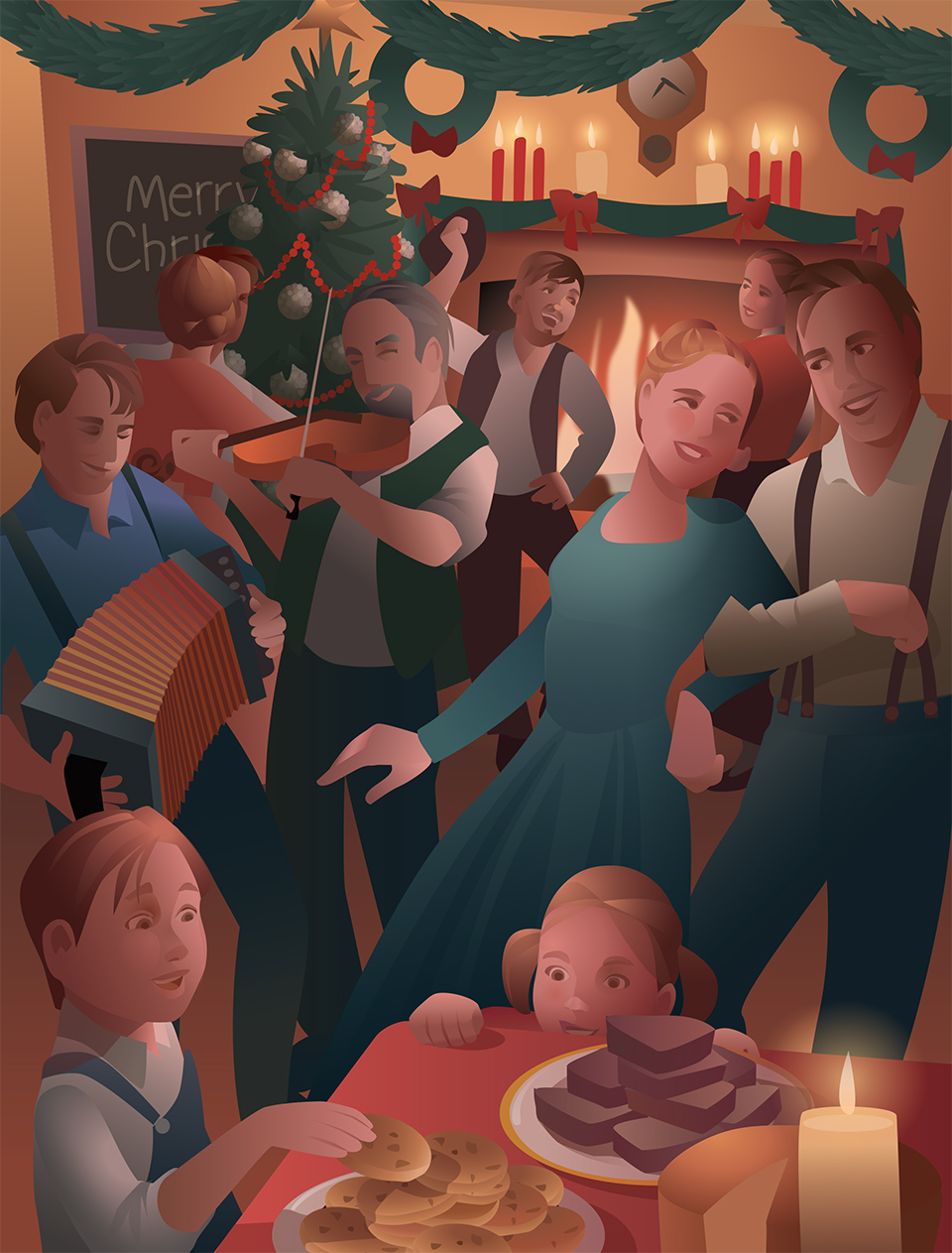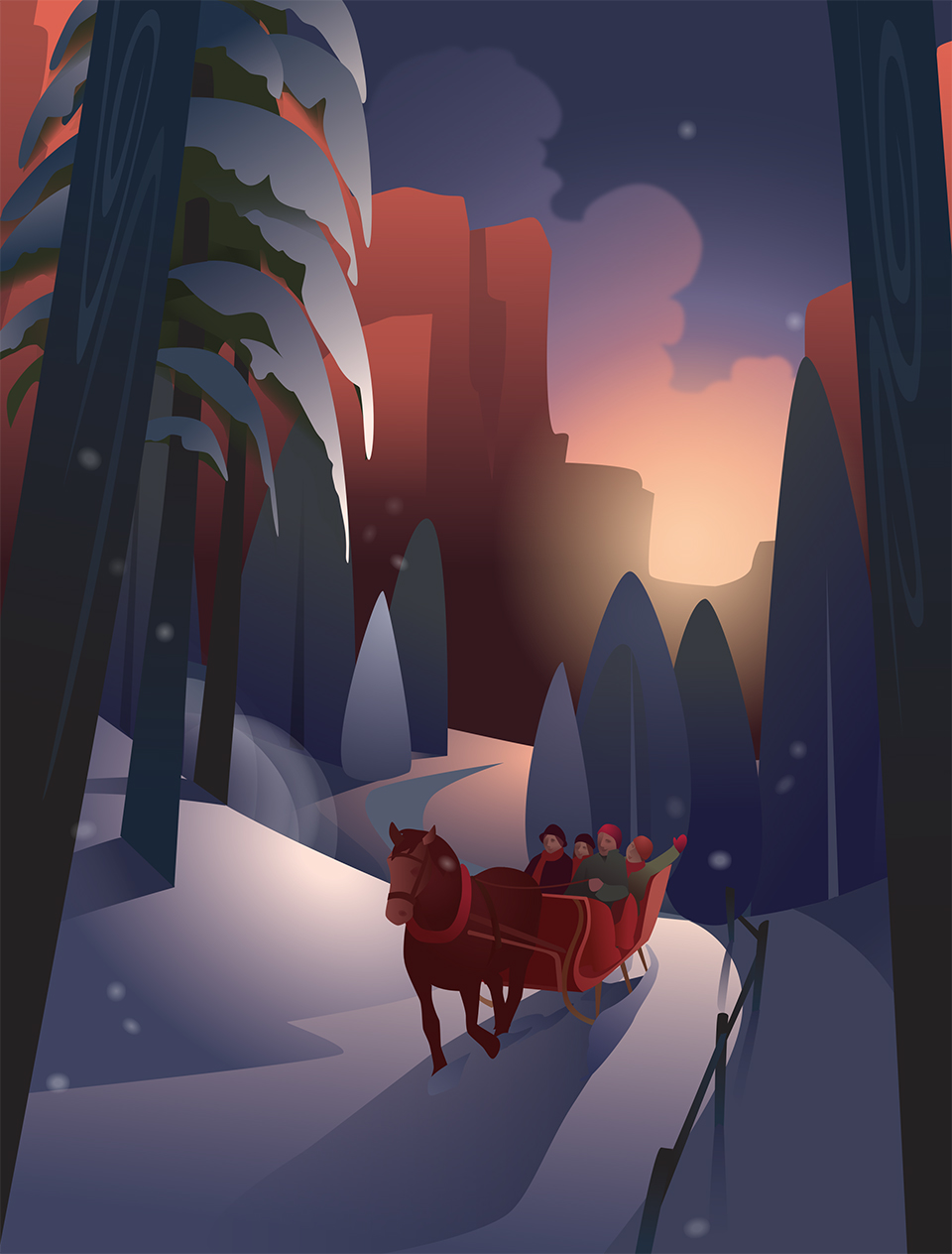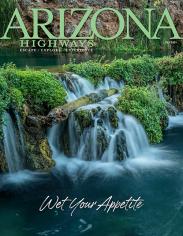Holiday celebrations in Sedona are a tradition as old as the town itself. Shops and restaurants deck the halls, and Tlaquepaque glows from the light of 6,000 luminarias. Winter promotions encourage visitors to enjoy a jeep tour, hike to a vortex or warm themselves with a cup of hot cider under glittering patio lights.
But holiday cheer looked a lot different in the early days. Because everything was different, including the weather. It was both colder and snowier, which would have made the idea of spending time outdoors sound a little crazy.
The daughter of one pioneer, for example, recalled watching her wash water turn to ice when it hit the ground the winter she stayed with her father in Oak Creek Canyon. When the snow was deep, which it often was, another dad wrapped his daughter’s shoes in gunnysacks to keep her feet warm, she recalled decades later.
“They would have snow on the ground from the 1st of October until late March at Indian Gardens,” says Paul Thompson, whose grandfather J.J. settled in Oak Creek Canyon in 1876. “They’d get snowstorms sometimes even into June.”
Paul’s father, Albert, recalled trudging to school along a trail the mail carrier had broken with his mule after a memorable storm in 1915. “The mule took mighty long steps coming downhill,” he wrote. “I just could not step that far in the deep snow. I had to almost crawl from one mule track to another. I made it, but I was tired, putting it mildly.” As late as 1947, the snow was so deep that workers reportedly could stand atop it and put the roof on the new market at Indian Gardens without using a ladder.
Surviving those harsh winters required months of preparation. “Mother made lots of sugar syrup before we had any fruit to put up for the winter,” Albert’s sister Clara wrote. “We dried tomatoes, corn, pumpkins and even string beans. We strung them like beads on a string and hung them up to dry.”
Her father bought flour by the ton, several hundred pounds of sugar and barrels of green coffee beans, which they roasted. One year, the creek stayed up so long that the Thompsons ran out of flour. J.J.’s horses bogged down in what now is the Village of Oak Creek while he was on his way to the closest store to buy more. It got so late that he had to stay overnight with the Armijo family, who sold him 100 pounds of their own flour to see his family through.
By the time the holidays arrived, settlers were ready to cut loose, and the schools were where they gathered. The first was built in Red Rock in the early 1890s. In the early 1910s, another opened on Brewer Road in Sedona. And for a very short time, a school operated during the summer months in Oak Creek Canyon.
Residents went to the schoolhouse to vote and to attend potlucks, plays and dances. Before churches were built, traveling preachers conducted worship services and kids attended Sunday school there. Social clubs met at the schools. And every year, students at the Red Rock and Sedona schools presented a Christmas program with readings, plays and music.

Many years later, teacher Edith Lamport Croxen recalled the Christmas celebration at the Brewer Road school in 1915. Students decorated a tall spruce with tinsel, candy and popcorn balls, she wrote. “Our Santa was one of the local fathers, all dressed in his red suit with white trimming, who talked to the youngsters and distributed their gifts,” she recalled. “Of course, our program was followed by the usual dance in which everyone took part. … At midnight a fine lunch was served. The coffee had been made in a five-gallon can over an open fire outside.”
Local talent provided the music, she continued: “Frank Derrick, the left-handed fiddler; Walter W. Van Deren, another fiddler; Jesse Purtymun played the accordion; and Albert Thompson played the accordion, too. After all the good time, which lasted until the wee small hours, the little ones, who had been sleeping, were awakened by their fond parents. Then all departed for their separate homes, tired and happy.”
While Croxen was spending the Christmas holiday with her family, a three-day storm left 64 inches of snow in Flagstaff, 37 inches at Indian Gardens and 2 feet all over the Verde Valley. Worried about getting back to school in time for classes to resume, the young teacher endured a difficult, multi-day journey back to Sedona. Arriving tired and weary at 9 p.m., she was surprised to find lights on in the schoolhouse. Snowbound residents had organized an impromptu dance, which was well underway. “They were really surprised to see us,” Croxen wrote. “No one had been out of Sedona since the beginning of this big storm.”
In a 2005 newspaper article, Sherman Loy was asked how people entertained themselves at Christmastime in the early days. Loy’s mother, Frieda, played the piano, he said, but the Thompson family was the real musical bunch. Several Thompsons played multiple instruments, including organ, piano, accordion, fiddle and guitar, and because J.J. had emigrated from Northern Ireland, the family’s music took on a Celtic flavor.
The dancing reflected the widely varied backgrounds of the settlers. Polkas, waltzes and “a kind of two-step” were in the mix, Loy said. But mostly, residents practiced an early form of ballroom dancing called the round dance, which could include a French gavotte, a Polish mazurka or a Bohemian schottische.
Loy’s maternal grandparents, Henry and Dorette Schuerman, had emigrated from Germany. When they settled at Red Rock, they brought their German traditions with them, says Loy’s daughter Kathie Loy-Gouhin. Those included decorating a tree with Christmas ornaments and lighted candles.
Christmas trees, in fact, originated in Germany in the 16th century, and Protestant reformer Martin Luther is credited with adding lighted candles. As late as the 1840s, Christmas trees were rare in America, because New England’s Puritans viewed them as pagan. The influx of German and Irish immigrants in the 19th century began to change that.
But it wasn’t until 1846, when England’s Queen Victoria and her German husband, Prince Albert, made Christmas trees fashionable, that they became widely accepted. Christmas ornaments were still manufactured only in Germany, though, until Woolworth’s began selling them in 1880, around when the Schuermans settled in Red Rock.
Dorette, especially, loved Christmas, says Sherman’s sister Martha. Each year, the Schuermans decorated a piñon pine with garlands of red pyracantha berries, candles and store-bought ornaments, which Dorette may have brought from Germany.
“We went up there every Christmas Eve and danced around the Christmas tree,” Martha says. “[Dorette] always had presents hidden in the closet and tempted us all to go in there. She really enjoyed the children. Santa Claus came, and it was usually my dad,” though she didn’t know that at the time, she adds. Frieda played the piano, and the whole family sang Christmas carols. There were always nuts, candied fruits and the fruitcake for which Dorette was known.
Martha and Kathie saved Dorette’s fruitcake recipe, along with ornaments, candle holders and Christmas gifts. There’s a cat, sewn from plaid cloth, that Frieda’s older sister gave her; a well-loved, homemade teddy bear; and a Play-Time tea set, with glass dishes and cups, in its original box.
“I know Grandma Schuerman also got everybody books,” says Kathie, who has a volume of Bible stories Dorette had inscribed to her father with gold lettering. “Grandma Schuerman was known for ordering special things for Christmas. Almost everybody showed up, because there were good presents. And she made a party of it.”

Dan Purtymun, who lived near the Thompsons in Oak Creek Canyon, remembered Christmas dances there, too. “We would get together with the Thompsons and either all go to their place, or they would come to ours,” he told an interviewer. “We would dance, and the mothers always cooked up lots to eat. We had pie and cake and lots of other things, especially meats.”
The cooking at the Thompsons’ house likely would have been Southern fare, Paul says. J.J. had served in the Confederate Army, and the family of his wife, Maggie James, had settled in the South, living in South Carolina, Arkansas and Texas, before coming West. Hominy was big, and pinto beans were a staple. “A lot of people had butter beans,” Paul says. “We never did raise butter beans. My dad didn’t like them.”
And, like most Southerners, the Thompsons ate more pork than beef. In his diary, fellow Verde Valley pioneer Dave Dumas wrote about driving 50 hogs from present-day Crescent Moon Ranch, at Red Rock Crossing, to Indian Gardens, Paul says: “He said it was like herding cats to finally get them there.”
Paul remembers that his grandparents had a big smokehouse for storing pork. “They would grind pork sausage and cook it, and take a big, 10-gallon crock and put a layer of fat in it and a layer of pork patties, and a layer of fat and a layer of pork patties, and put it down in the cellar, and it would last down there for several months,” he says. “They raised turkeys and chickens both, so I suppose they were on the menu, too.”
And Maggie likely would have done a lot of baking. “That’s what my mother used to do for Christmas,” Paul says. “My mother used to make gingerbread and sugar cookies with frosting. And she baked a lot of cakes. I would imagine my grandmother did, too. They made berry pies and pumpkin pies, because they raised a lot of pumpkins and they had a lot of wild blackberries up there.”
Albert told Paul that oranges were the most prized gifts. J.J. freighted around Camp Verde and Jerome and would bring the oranges in from Jerome or Flagstaff. The kids also generally got a small toy of some kind.
Not much is left of the old schools. When the Red Rock school closed in 1947, Martha’s father used the lumber to add a bathroom to their house across the street, on the homestead Martha’s mother had inherited from Henry and Dorette. Only the stone foundation of the school remains. The original school building on Brewer Road was struck by lightning the next year and burned down, but newer portions of the school hosted classes, then district offices, for decades afterward.
Martha and Paul are among the last to have attended both schools and taken part in the old traditions, which remained remarkably unchanged. “We’d go out on the ranch and cut a piñon pine, and the kids would decorate it,” says Paul, whose fourth-grade class was the last to attend the Red Rock school. “We’d cut up colored construction paper and make paper chains with library paste. The tinsel then was lead foil. It was nice and shiny, but it was heavy.
“They’d have a school program. And the people in the community would come. That old schoolhouse … didn’t have electricity. We had kerosene lamps along the windows, and they would light those and bring food for when the Christmas ‘get’ was over and have our big Christmas celebration. In Sedona, they’d bring blankets and bed the kids down behind the desks and dance till dawn. About the only thing left of that school is the bell at the Sedona [Heritage Museum].”
But the stories live on in the memoirs of the pioneers and the memories of the old-timers. Meanwhile, a new generation has created its own traditions. Tlaquepaque celebrated the 50th anniversary of its Festival of Lights last year, and it now includes a menorah lighting for Hanukkah. No doubt, some families have visited every one of those years, bringing kids who now bring their own kids. Because of the milder winters and better roads, they can now enjoy that hike or jeep tour and shop in stores that are nearby, well stocked and abundant.
But Paul Thompson is grateful to have lived in Sedona when he did. “It was a wonderful place,” he says, “for a kid to grow up.”

